Europe, British Isles, South-West England, Wiltshire, Stonehenge Landscape, Stonehenge Barrows, Lake Group Barrows
Lake Group Barrows is in Stonehenge Barrows, Stonehenge Bronze Age Barrows.
Stonehenge by William Stukeley. Table XXXI. A Prospect of the barrows in Lake field called Eleven barrows & lately the prophets barrows. 2d. Sepr. 1723. A. Stonehenge. Barrow opened by L. Pembroke. SS. by Stukeley.
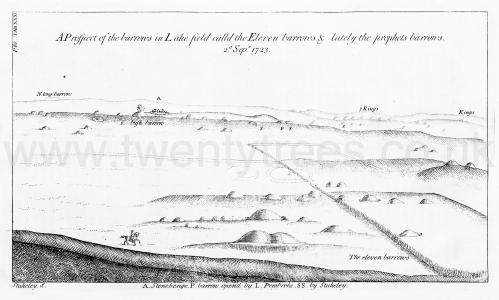
Europe, British Isles, South-West England, Wiltshire, Stonehenge Landscape, Stonehenge Barrows, Lake Group Barrows, Lake Group Barrow 1 [Map]
Lake Group Barrow 1 is also in South England Neolithic Long Barrows.
Colt Hoare 1812. No. 1 [Map] is a long barrow, situated at the south-west extremity of the group, and like many others of a similar form has not been opened, as they have in general proved so uniform in their modes of sepulture, and so very unproductive in articles of curiosity.
Wiltshire Archaeological Magazine 1913 V38 Pages 379-414. Wilsford. 41. [Lake Group Barrow 1 [Map]] S.W. of Stonehenge. No. 1 of Hoare's Lake Group. Length 169ft.; S.E. and N.W. No recorded opening. It is now in a plantation, but is otherwise in fair condition. O.M. 63 N W.; A. W. I. 209.
Europe, British Isles, South-West England, Wiltshire, Stonehenge Landscape, Stonehenge Barrows, Lake Group Barrows, Lake Group Barrow 2 [Map]
Colt Hoare 1812. The diminutive barrow, No. 2 [Map], produced, just under the surface, the very rude and perfect little cup engraved in Tumuli Plate XXX, No. 1, which is perforated at bottom like a cullender, and has holes on the sides for suspension. This article seems to corroborate the idea I started in my Introduction, that these small vases might, without any great impropriety, be called INCENSE CUPS, in which aromatic oils and perfumes, according to ancient usage, were burned and suspended over the funeral pile. This cup accompanied an interment of burned bones.
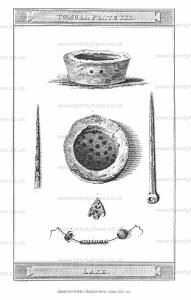
Europe, British Isles, South-West England, Wiltshire, Stonehenge Landscape, Stonehenge Barrows, Lake Group Barrows, Lake Group Barrow 3 [Map]
Colt Hoare 1812. No. 3 [Map] and No. 4 [Map] had been previously opened by other people.
Europe, British Isles, South-West England, Wiltshire, Stonehenge Landscape, Stonehenge Barrows, Lake Group Barrows, Lake Group Barrow 4 [Map]
Colt Hoare 1812. No. 3 [Map] and No. 4 [Map] had been previously opened by other people.
Europe, British Isles, South-West England, Wiltshire, Stonehenge Landscape, Stonehenge Barrows, Lake Group Barrows, Lake Group Barrow 5 [Map]
Colt Hoare 1812. No. 5 [Map] was investigated by Mr. Cunnington, in 1805, who found in it an interment of burned bones, with 20 or 30 small black beads, which appear to have been composed of earth or wood, and to have passed the fire.
Europe, British Isles, South-West England, Wiltshire, Stonehenge Landscape, Stonehenge Barrows, Lake Group Barrows, Lake Group Barrow 6 [Map]
Colt Hoare 1812. No. 6 [Map] is one of the finest barrows in this group, and is 13 feet 9 inches in elevation. On making our section, the workmen had the good fortune to dig close to the side of a large sepulchral urn which stood within one foot of the surface, without injuring it. It was rudely formed and baked, measured 15 inches in height, and 13 in width and was placed with its mouth downwards over a large pile of burned bones, amongst which was a fine ivory bodkin, Plate XXX. No. 2. At a further depth of five feet were the remains of two skeletons; and at the bottom of the barrow, and total depth of 13 feet 9 inches, was an oblong cist, five feet deep, and seven feet long, cut in the chalk, containing the skeleton of a child, apparently not more than two or three years old, accompanied by a drinking cup.
The history of this tumulus, which our learned Doctor would, from its superior size and beautiful form, have styled a KING BARROW, shews what little regard we ought to pay to system; for here, at the vast depth of nearly 14 feet, we find only the deposit of an infant, accompanied by a simple drinking cup. Whilst in No, 21, a mean and insignificant barrow, we discover articles of the greatest beauty and importance. The motto of fronti nulla fides may be justly and strictly applied to barrows; and the antiquary who makes them his study must neither be disappointed in finding only a simple interment in the largest barrow, and the finest urns and most precious trinkets in the smallest. Curiosity, however, is equally kept on the alert; and it matters little whether we gain our information by the operations of the spade on a large or a diminutive tumulus.

Europe, British Isles, South-West England, Wiltshire, Stonehenge Landscape, Stonehenge Barrows, Lake Group Barrows, Lake Group Barrow 7 [Map]
Colt Hoare 1812. No. 7 [Map] is a large bell-shaped barrow, composed entirely of vegetable earth. It contained, within a cist, a little pile of burned bones, with which had been deposited a very fine brass pin, a large stone bead which had been stained red, a bead of ivory, and a lance-head of brass, Plate XXX. No. 3, 4.

Europe, British Isles, South-West England, Wiltshire, Stonehenge Landscape, Stonehenge Barrows, Lake Group Barrows, Lake Group Barrow 8 [Map]
Colt Hoare 1812. No. 8 [Map] is a very wide and flat barrow, elevated about six feet from the ground, and supposed to be the one from which the French Prophets1, about the year 1710, delivered their doctrines, as its summit presents an even surface of 48 feet in diameter. To ensure success in a mound of such magnitude, we were obliged to make a very large section, in which, at the depth of two feet, we came to the top of a pile of marl, which encreased in size as we approached the floor. After considerable labour we found, on the north side of our section, the cist from whence this marl had been thrown out; it was eight feet and a half long, and above two feet wide, and contained a pile of burned human bones, which bad been enclosed within a box of wood. Near the bones lay a fine spear-head, [Plate XXVIII. No. 7.] and a whetstone. From the singular form and extraordinary size of this barrow, we expected to have made more important discoveries; and though most probably we found the primary deposit in the centre or place of honour, it is not at all unlikely that the sides of this large mound might produce other sepulchral deposits.
Note 1. Dr. Stukeley says, that the country people call this group the Prophet's barrows, because the French prophets, 30 years ago (A. D. 1710 set up a standard on the largest barrow, and preached to the enthusiastic multitude." Among the multitude of protestants who fled from France in consequence of the horrible persecutions which followed the revocation OF the Edict of Nantz, were same enthusiasts, who pretended to the gift of prophecy, and other spiritual gifts. These enthusiasts travelled over various parts of the kingdom preaching ta the people, and according to tradition, the summit of one of these barrows was chosen as a fit place for the prophet's oration.
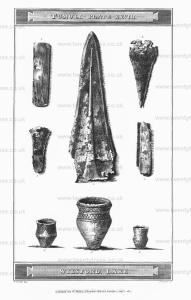
Europe, British Isles, South-West England, Wiltshire, Stonehenge Landscape, Stonehenge Barrows, Lake Group Barrows, Lake Group Barrow 9 [Map]
Colt Hoare 1812. No. 9 [Map]. A fine bell-shaped barrow, ten feet in elevation, produced only a simple interment of burned bones on the floor.
Europe, British Isles, South-West England, Wiltshire, Stonehenge Landscape, Stonehenge Barrows, Lake Group Barrows, Lake Group Barrow 10 [Map]
Colt Hoare 1812. In No. 10 [Map] we made two trials, but without success, having found nothing but the skeleton of a dog, and the head of a deer.
Europe, British Isles, South-West England, Wiltshire, Stonehenge Landscape, Stonehenge Barrows, Lake Group Barrows, Lake Group Barrow 11 [Map]
Colt Hoare 1812. No. 11 [Map] and No. 12 [Map] are two fine Druid barrows, which, from the little trouble attending the opening of them, had excited the curiosity of former antiquaries.
Europe, British Isles, South-West England, Wiltshire, Stonehenge Landscape, Stonehenge Barrows, Lake Group Barrows, Lake Group Barrow 12 [Map]
Colt Hoare 1812. No. 11 [Map] and No. 12 [Map] are two fine Druid barrows, which, from the little trouble attending the opening of them, had excited the curiosity of former antiquaries.
Europe, British Isles, South-West England, Wiltshire, Stonehenge Landscape, Stonehenge Barrows, Lake Group Barrows, Lake Group Barrow 13 [Map]
Colt Hoare 1812. No. 13 [Map] produced a simple interment of burned bones.
Europe, British Isles, South-West England, Wiltshire, Stonehenge Landscape, Stonehenge Barrows, Lake Group Barrows, Lake Group Barrow 14 [Map]
Colt Hoare 1812. In No. 14 [Map] and No. 15 [Map] we see a kind of double barrow, the smallest end of which had been opened before. The floor of the larger mound was strewed with an immense quantity of wood ashes, and in a small oblong cist we discovered an interment of burned bones, together with four glass pully-beads, one of stone1, two of amber, and a brass pin. This last tumulus is separated from the former group by a bank and ditch, which once formed an old enclosure, for from its situation, and slightness, I cannot consider it as an encampment.
Note 1. The bead of stone, and one of glass, are engraved in Plate XXX. No. 6, 7.

Europe, British Isles, South-West England, Wiltshire, Stonehenge Landscape, Stonehenge Barrows, Lake Group Barrows, Lake Group Barrow 15 [Map]
Colt Hoare 1812. In No. 14 [Map] and No. 15 [Map] we see a kind of double barrow, the smallest end of which had been opened before. The floor of the larger mound was strewed with an immense quantity of wood ashes, and in a small oblong cist we discovered an interment of burned bones, together with four glass pully-beads, one of stone1, two of amber, and a brass pin. This last tumulus is separated from the former group by a bank and ditch, which once formed an old enclosure, for from its situation, and slightness, I cannot consider it as an encampment.
Note 1. The bead of stone, and one of glass, are engraved in Plate XXX. No. 6, 7.

Europe, British Isles, South-West England, Wiltshire, Stonehenge Landscape, Stonehenge Barrows, Lake Group Barrows, Lake Group Barrow 16 G47 [Map]
Europe, British Isles, South-West England, Wiltshire, Stonehenge Landscape, Stonehenge Barrows, Lake Group Barrows, Lake Group Barrow 17 G48 [Map]
Europe, British Isles, South-West England, Wiltshire, Stonehenge Landscape, Stonehenge Barrows, Lake Group Barrows, Lake Group Barrow 18 G50a [Map]
Europe, British Isles, South-West England, Wiltshire, Stonehenge Landscape, Stonehenge Barrows, Lake Group Barrows, Lake Group Barrow 19 G50 [Map]
Colt Hoare 1812. but though No. 20 [Map] [Note. This appears to be a mistake for 19?] had also a lance-head, the uniformity was most pleasantly broken by the discovery of four carious little articles of bone, which were intermixed with the ashes and burned bones. They are a perfect novelty, and had their meaning and use in British times; though in the more modern and enlightened period of the present day, we are at a loss to conjecture what that meaning and what that usage were. The obverse and reverse of each is faithfully delineated in Tumuli Plate XXXI by which you will perceive that the superficies is flat on one side, and convex on the other; they are made of bone, which appears to have been stained and polished by attrition; and each side is marked with a different pattern and device, except in one instance, where both sides are left blank. We might be led to suppose by this circumstance that the custom of casting lots existed amongst the Britons; and that these articles were appropriated to that purpose; or, perhaps, they might have been used like the ancient talus or tessera, for some kind of game. But in whatever light we view them, they must be considered as the greatest curiosities we have ever yet discovered; and as forming a slight progressive step towards language and civilization. 1
Note 1. The custom of casting lots prevailed in the earliest times amongst the nations antiquity, and a late ingenious traveller, Mr. Barrow, informs us that it is still continued in China.
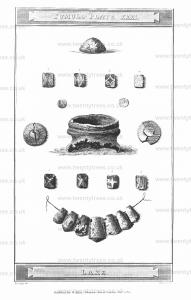
Europe, British Isles, South-West England, Wiltshire, Stonehenge Landscape, Stonehenge Barrows, Lake Group Barrows, Lake Group Barrow 20 G49 [Map]
Colt Hoare 1812. No. 21 [Map] [Note. This appears to continue the previous mistake and number 20 as 21?] is a wide and low tumulus, over which the plough has performed its agricultural rites for many years. The mode of interment was here varied, and the very rich and numerous trinkets discovered in this barrow, seem to announce the skeleton to have been that of some very distinguished British female. The most remarkable of these, and unique in size, though not in pattern, was an ornament of amber, similar to that before engraved in Tumuli Plate III. but far exceeding it in all its proportions, being ten inches in height and above three in breadth; it is formed of eight instead of six distinct tablets, and by being strung together, formed one ornament, as may be distinctly seen by the perforations at top and bottom. Besides the above were numerous beads of amber of much larger proportions than usual, and varying in their patterns, four articles of gold perforated, perhaps for ear-rings, and two small earthen cups, the one about seven or eight inches deep, the other little above an inch. The largest of the beads, the gold ornaments, and the fragment of the smallest cup are engraved of their full size in Tumuli Plate XXXI.
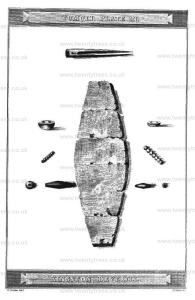

Europe, British Isles, South-West England, Wiltshire, Stonehenge Landscape, Stonehenge Barrows, Lake Group Barrows, Lake Group Barrow 21 G50c [Map]
Colt Hoare 1812. No. 21 [Map] had been opened before; but. amongst the earth and scattered bones, we found some fragments of a fine drinking cup, some chipped flints, and one perfect arrow-head of flint.2
Note 2. Engraved in Plate XXX, No. 5.

Europe, British Isles, South-West England, Wiltshire, Stonehenge Landscape, Stonehenge Barrows, Lake Group Barrows, Lake Group Barrow 22 G51 [Map]
Colt Hoare 1812. No. 22 [Map] had also been partially opened, for amongst the unburned bones which had been moved, we found the remains of two neatly ornamented drinking cups; and an digging towards the south-east, we discovered the skeleton of a child, and over it a drinking cup.3
Note 3. Engraved in Plate XXVIII, No. 8.

Europe, British Isles, South-West England, Wiltshire, Stonehenge Landscape, Stonehenge Barrows, Lake Group Barrows, Lake Group Barrow 23 G53 [Map]
Colt Hoare 1812. No. 23 [Map] contained a simple intennent of burned bones within a cist made in the form of a cone;
Europe, British Isles, South-West England, Wiltshire, Stonehenge Landscape, Stonehenge Barrows, Lake Group Barrows, Lake Group Barrow 24 G52 [Map]
Colt Hoare 1812. and No. 24 [Map] produced a similar interment immediately under the turf with fragments of a drinking cup, Two feet lower down, we discovered another deposit of burned bones immediately over the head of a skeleton; and beneath this we found a second skeleton lying with its head towards the north-west, and several large pieces of stag's horns by its side.